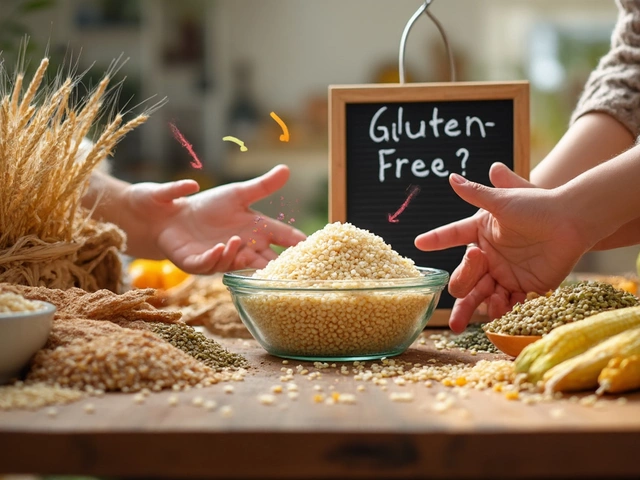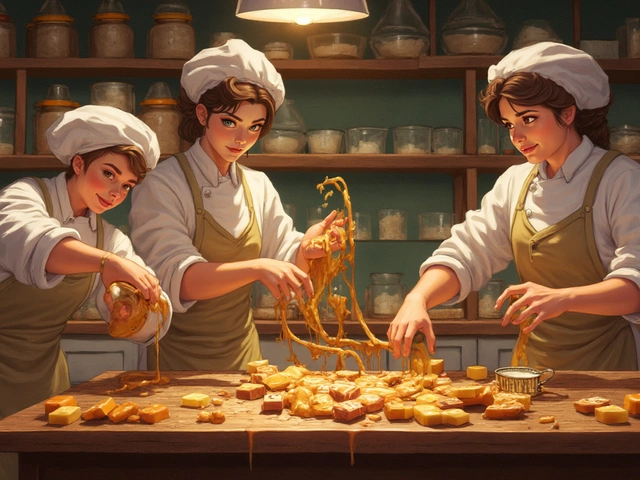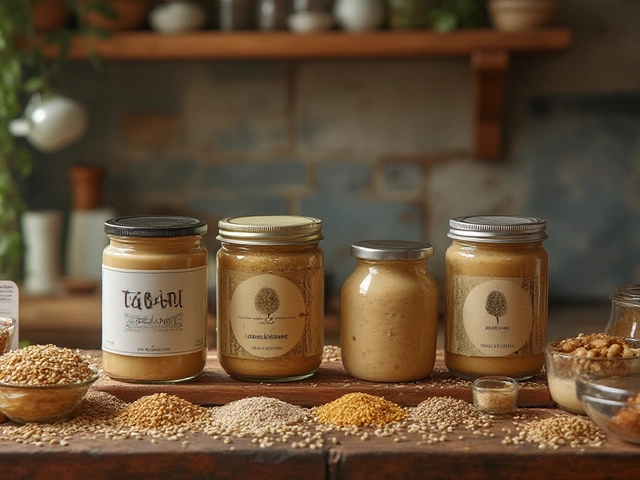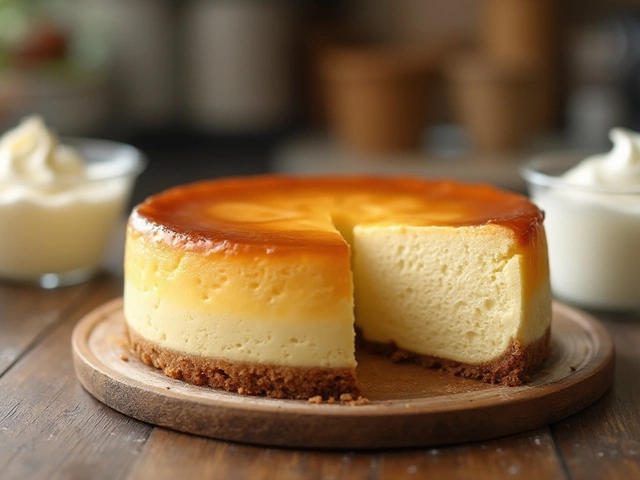
Ah, fudge! That sweet, indulgent confection that has won hearts across continents. Its roots trace back to America, a mound of sugar, dairy, and butter, whipped together into a creamy, dreamy treat that refuses to go unnoticed. So, what exactly makes American fudge so unique and beloved?
For those venturing into the realm of fudge-making, it's quite fascinating to unearth how such humble ingredients transform into a delightful snack. The recipes have evolved, so let's unfurl some of those time-tested techniques and mouth-watering flavors that have been forming memories over generations.
From simple vanilla and chocolate to more adventurous caramel and nutty variations, there's a world of choice out there. Alongside historical gems, practical tips, and creatively easy recipes, this exploration offers everything you need to whip up your batch of sweet bliss.
- Origins and History
- Basic Ingredients and Techniques
- Popular Flavors and Variations
- Tips for Perfect Fudge
- Easy Fudge Recipes to Try
Origins and History
The delightful confection known as American fudge has quite a charming and somewhat mysterious history that captures the imagination as much as the palate. It all started in the late 19th century, with the first known batch said to have been born out of a sweet accident. As the story goes, a young baker in Baltimore accidentally 'fudged' a batch of caramels, inadvertently inventing this new soft candy, hence the name 'fudge.' This delightful misstep sparked the creation of an entirely new treat that would quickly grow in popularity.
Around 1886, fudge made its debut at Vassar College in Poughkeepsie, New York, when a student reportedly started selling it for 40 cents a pound. The success among students rapidly transformed it from a homemade goodie to a famed dessert staple. By the early 1900s, recipes began appearing in home cookbooks across the United States, reinforcing its status as a household favorite. It was during this period that fudge found its solid place in the kitchens and hearts of many Americans.
Across the Atlantic, though not rooted in their own culinary tradition, fudge found its way into the British homes as well, albeit much later. Distinct from its heavier British toffee counterpart, American fudge offered a lighter, creamier alternative, thereby capturing the affections of dessert lovers worldwide. An interesting flavor convergence happened over time; European chocolatiers later influencing the numerous flavor explorations in fudge, ranging from classic chocolate to more refined variations.
"Fudge isn't just a sweet treat; it's a piece of American folklore," noted food historian Andrew Smith. "It's woven into the fabric of our culinary culture, representing both innovation and indulgence."
In today’s world, fudge is often synonymous with holidays and special occasions, where families gather in kitchens to create what has become a sugary symbol of warmth and festivity. It's a moment where everyone, from grandparents to children, lends their hand to stirring and crafting unique flavors that have infused the traditional with the contemporary. This beloved treat's journey from a serendipitous mistake to an all-American classic speaks volumes about its enduring appeal and adaptability.
Basic Ingredients and Techniques
Diving into the world of American fudge reveals a recipe centered on a few key ingredients, each playing their part to create that perfect mouthfeel. Despite its simplicity, mastering fudge is about understanding the alchemy of sugar, butter, and milk — or cream, depending on the indulgence level one desires. Sugar acts as the foundation, typically granulated or castor sugar, which is dissolved and brought to a specific temperature to yield the characteristic texture. Milk or cream provides richness, offering depth and a smooth, luxurious finish. Unsalted butter contributes to flavor; its fat content critical for softening the texture and lending a glossy sheen to completed fudge. The choice of sweetener affects the outcome, too, with variations including brown sugar for a deeper, caramel-like flavor profile. It's worth noting that creating fudge is equal parts science and art, requiring patience and attention to detail. A sugar thermometer is an indispensable tool, ensuring precision as the confection approaches soft-ball stage, roughly 235°F (113°C), where sugar syrups transform into the initially malleable and eventually firm candy we savor.
But it doesn't end with just sugar, butter, and milk. The method in which these ingredients are combined can elevate a basic recipe to perfection. Start by dissolving sugar in a saucepan over low heat, incorporating milk or cream gradually — this prevents the sugar from crystallizing prematurely on the pan's surface, which might happen if one rushes through this initial step. Butter is then introduced, blending together and enhancing the mixture's texture. Once all elements are fully combined, the real craft unfolds; stirring diligently as the mix simmers is crucial, ensuring it doesn't scorch and spoil the subtle flavor nuances. Fudge requires cooling before it sets entirely, turning it out on a buttered or parchment-lined surface to rest. As it cools, this is the moment for creativity, introducing flavorings or mix-ins, like chocolate chips or vanilla extract, whisking them thoroughly for an even distribution.
"The perfect fudge is a balance of exactness and creativity," says renowned pastry chef, Claire Ptak, "Precision is key, yet the room for flavors is endless."Avoidance of stirring too vigorously when the fudge begins to thicken is crucial, as excess handling can cause gritty textures, rather than that velvety smoothness that defines delicious fudge. This delicate dance of ingredients and technique is what makes American fudge not only a timeless treat but a testament to culinary craftsmanship.

Popular Flavors and Variations
When it comes to American fudge, variety is indeed the spice of life. The classic flavors, like chocolate and vanilla, lay a timeless foundation. Chocolate fudge, with its dark, sultry richness, has been the hallmark of the fudge world. The cocoa's bitterness balanced with sugar creates a deeply satisfying treat that's hard to resist. Vanilla fudge, on the other hand, charms with its sweet simplicity. A perfect backdrop for other ingredients, it allows experimentation with textures and tastes.
In the realm of adventurous flavors, peanut butter fudge stands virtually unparalleled. The creamy, nutty robustness mingles with dense sweetness, creating a heavenly combination popular among confectionery enthusiasts. Then there's maple walnut fudge, a tribute to nut aficionados, blending the earthiness of walnuts with the sweet, smoky aroma of maple syrup. This combination not only appeals to the taste buds but offers an engaging texture that keeps the senses intrigued.
For those who prefer a chew in their confectionery, rocky road fudge is a bona fide choice. Laden with nuts, mini-marshmallows, and a sprinkling of dried fruits, every bite is a textural extravaganza. It's a carnival of flavors that engage all senses, celebrated for the delightful contrast between soft and crunchy. This type of fudge is often made with adjustments to the basic recipe to account for the complex ingredient mix, ensuring a balanced, cohesive flavor profile.
Mint chocolate fudge introduces a refreshing twist, venturing into the territory usually reserved for chocolates. The mint cuts through the richness, leaving a cool aftertaste that is as invigorating as it is indulgent. Cheesecake fudge is an emerging variation, creatively merging the creamy tang of cheesecake with fudge's sweet intensity, offering a truly gourmet spin. Those with a penchant for the great outdoors might appreciate s'mores fudge, capturing the campfire classic's essence with its marshmallow, graham cracker, and chocolate ensemble.
As the world explores healthier indulgences, there's a rise in plant-based ingredients used in fudge-making. Using coconut or almond milk in place of dairy has gained momentum, allowing for vegan-friendly alternatives that don't compromise on flavor. These variations often incorporate naturally occurring sugars, such as those from dates, providing an authentic sweetness with a lower glycemic index compared to traditional recipes. A
Culinary expert Amy Bales once noted, "The expansion of flavors and ingredient substitutions makes American fudge not just a treat, but a cultural experience – a sweet canvas for innovation."
Recognizing the seemingly infinite variations available, it becomes clear that fudge recipes not only encompass delightful tastes but embody personal expression and creative culinary art. Here’s a simple glance at some of the popular variations:
- Chocolate Fudge
- Vanilla Fudge
- Peanut Butter Fudge
- Maple Walnut Fudge
- Rocky Road Fudge
- Mint Chocolate Fudge
- Cheesecake Fudge
- S'mores Fudge
- Vegan-friendly Fudge
Each variety offers an adventure, a journey through sweet indulgence, taking both creators and consumers to unexpected culinary heights. The creativity in crafting these flavors ensures that American fudge remains as diverse and dynamic today as it was when it first splashed onto the scene many years ago.
Tips for Perfect Fudge
Creating the perfect batch of American fudge is an art that combines science, patience, and a touch of creativity. Understanding the process and mastering some simple techniques can elevate your fudge-making experience. Begin with the tried-and-true trifecta of ingredients: sugar, butter, and milk or cream. These lay the foundation, but it's essential to pay attention to the proportions and temperatures. Consistency is king, and the texture of your fudge relies heavily on timing and heat control. Melt the butter and sugar slowly, stirring gently to dissolve the granules, ensuring nothing burns or sticks to the sides of your pot. It's common knowledge among seasoned confectioners that using a heavy-bottomed pan can distribute heat more evenly, preventing scorching. One handy trick is to test the mixture by letting a small amount drop into cold water. When it forms a soft ball, you're nearing the ideal stage of readiness.
Accuracy with temperature measurement can transform good fudge recipes into great ones. The magic happens around 234°F to 237°F, known as the 'soft-ball stage.' A digital candy thermometer can be an indispensable tool here, sparing you guesswork. However, if you prefer the old-fashioned method, drop a spoonful into a bowl of cold water and see if it forms a pliable, yet firm ball. Timing is key even after you remove the mixture from heat. Allow it to cool without agitation until it reaches roughly 110°F; that's when it's time to stir vigorously for a smooth, creamy texture. As the fudge cools, it will thicken and set into a perfectly luscious consistency. Remember, patience is more than a virtue; it's the secret sauce that helps these simple ingredients transform into melt-in-the-mouth bliss.
Every sweet treat has its secrets, and American fudge is no different. Tradition suggests adding a splash of vanilla extract after removing from heat, as it preserves the flavor, enriching your batch with a warm, aromatic note. For those keen on experimentation, this stage is also your opportunity to add extras like nuts, chocolate chips, or marshmallows into the mix. Be warned that add-ins must be folded in swiftly to prevent grittiness as the fudge sets. One might be surprised to discover how the different variables interact to influence texture and flavor, but knowing when to be gentle and firm with your batch is the essence of it all.
Marcy Goldman, a renowned baker, once said, "Good fudge should be firm but not too hard, delicately balanced between chewy and crumbly."Be it simple or elaborate, each batch can tell your culinary story differently.
If you're struggling to achieve the perfect consistency consistently, here's a tip: practice truly does make progress. Understanding the temperature, timing, and texture of each stage takes time, but these small adjustments can brighten your path to mastering the art of fudge-making. You may even want to jot down a few variations in cooking times and temperatures as a personalized guide for future adventures in fudge. A well-kept fudge journal could become an unexpected treasure trove, capturing discoveries like perfect thickness, preferred sweetness levels, and exciting add-in combinations. Just remember, any blunders along the way are merely delicious detours. So start with the basics, embrace each lesson, and savor every sweet success along the journey.
As knowledge grows, so does confidence. When it all clicks – from technique to ingredient choice – nothing beats the satisfaction of creating a faultless, creamy batch of American fudge. Whether you're making it as a gift or for personal indulgence, the effort put into understanding these nuances pays off with a product that delights both the maker and those lucky enough to enjoy it. So, pick up your spoon, find your favorite recipe, and dive in. Mastering fudge isn’t just about the result; it's about the experience wrapped in the sweet, delightful discoveries along the way. You may find that the best batch is not measured simply by taste, but by the love and care poured into each melting morsel.
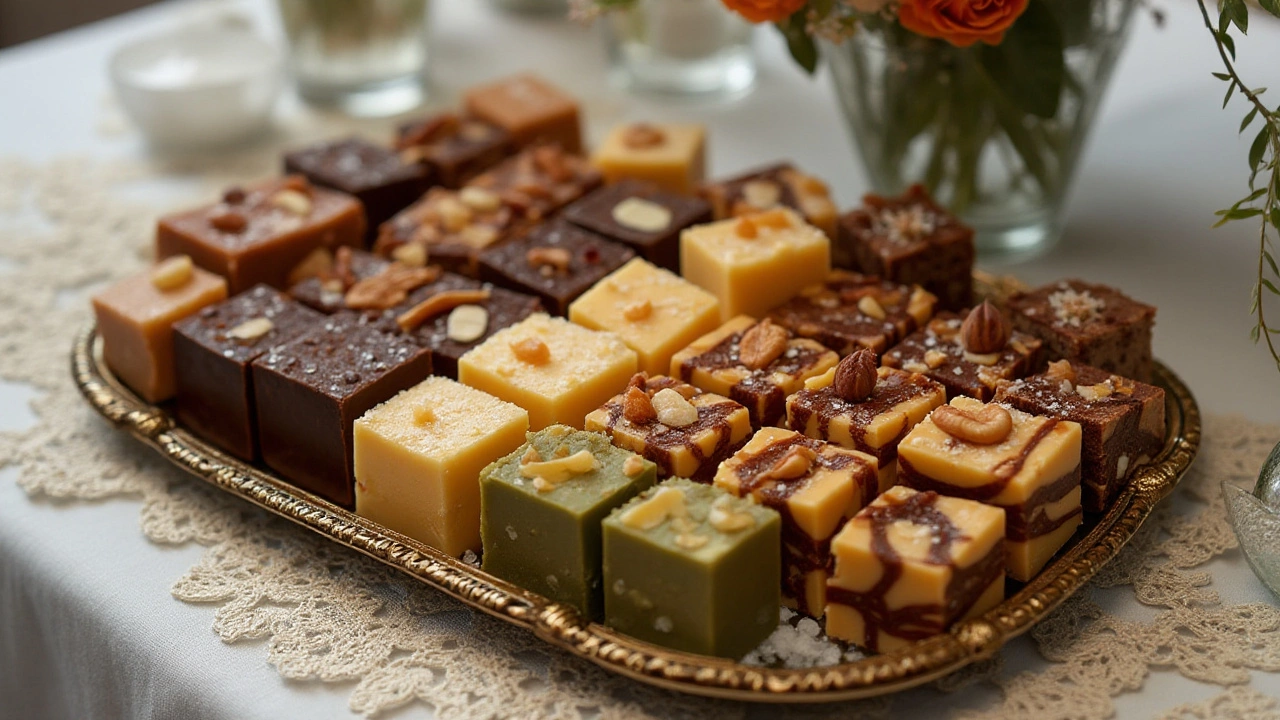
Easy Fudge Recipes to Try
Creating a batch of homemade American fudge is an artful yet accessible journey that even novice confectioners can delight in. With just a few staple ingredients, you can whip up a batch of this universally adored sweet treat, perfect for sharing or savoring quietly. Let's delve into two classic recipes: the velvety smooth chocolate fudge and the luxuriously rich peanut butter fudge, each promising loads of satisfaction without the need for complicated techniques.
Classic Chocolate Fudge
Our first recipe, the classic chocolate fudge, requires nothing more than sugar, cocoa, butter, and milk. It begins by mixing sugar and cocoa, providing that quintessentially rich chocolatey flavor. Adding a dollop of butter and a splash of milk, the mixture is stirred continuously over medium heat. Achieving the perfect consistency is crucial, and it becomes evident when the mixture starts pulling away from the sides of the pan. Once removed from heat, a dash of vanilla enhances the flavor profile. Finally, pouring the decadent blend onto a prepared dish and allowing it to cool transforms these ingredients into squares of irresistible fudge."The best fudge is one that's made with love and shared generously," suggests Martha Stewart, echoing her philosophy of homely delight.
Peanut Butter Fudge
Next, let's explore peanut butter fudge, an irresistible variation that introduces a creamy, nutty twist. Begin by melting the butter in a saucepan over moderate heat and stirring in sugar and milk, much like the chocolate version. Allow it to steadily come to a rolling boil while you prepare your peanut butter and vanilla essence. Once the sugary blend reaches an optimal boiling point, it is withdrawn from heat, and in goes the peanut butter, melting beautifully into the hot mixture. The dough-like blend eagerly settles into pre-prepared trays, offering cookies of delicious fudge goodness as they cool to room temperature. Slicing into these squares reveals the rich, smooth texture that defines homemade delights.Key Ingredients and Techniques
Now, why do these recipes work so well? The key lies in mastering the balance of sweetness and creaminess. The use of high-quality cocoa for chocolate fudge and creamy peanut butter for its tonal counterpart can make a world of difference. According to a study by the Culinary Institute of America, ensuring the right consistency by heating to the recommended temperature is vital in achieving the ideal firm yet soft-when-biting texture; otherwise, faults such as graininess may occur. Here, a simple candy thermometer becomes an invaluable tool for precise monitoring.Moreover, employing fresh vanilla extract instead of synthetic essence subtly elevates the flavoring for a truly superior taste experience. These simple tips are a testament to how easy and rewarding crafting these recipes can be, fostering a deeper appreciation for the humble yet indulgent world of fudge.

